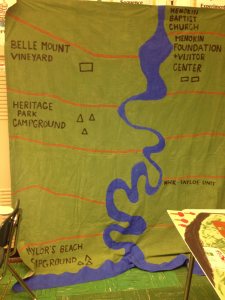Virginia is steeped in history, much of it originating in the Northern Neck. Yet the reality of our locals schools means bare-bones budgets, and few or no field trips for students to learn about and explore the myriad historic venues right here in their back yards.
 Enter History on the Go. This local program provides regional elementary and middle school students an overview of some of the great educational resources available to them within the Northern Neck and Middle Peninsula.
Enter History on the Go. This local program provides regional elementary and middle school students an overview of some of the great educational resources available to them within the Northern Neck and Middle Peninsula.
Collaborating cultural institutions develop presentations and coordinate with the schools for an immersion event. Five or six stations are set up in the school gymnasium or auditorium. Each class rotates around the room to visit every station, spending 15 minutes learning about, and participating in, a different activity related to that particular site.
On December 4th participating organizations brought their messages to Richmond County Elementary 4th and 5th graders. A whopping 176 students shared in these programs:
Belle Isle State Park – Animal Adaptations. This station exhibited various animal skins and casts of various footprints. Students learned about living and hunting habits of native species in this region.
Mary Ball Washington Museum and Library – 18th century school, reading and writing. Students discussed a one room classroom environment, using a replica of a classroom. The students practiced writing on slates and used a quill pen on paper. Discipline and games were also discussed.
Middlesex Museum and Historical Society – Historical documents and court  cases. Students reviewed copies of original court records re slaves, property and possessions, and insurance documents and discussed the importantance of record keeping.
cases. Students reviewed copies of original court records re slaves, property and possessions, and insurance documents and discussed the importantance of record keeping.
Reedville Fisherman Museum – Life cycle and history of oysters and watermen. Showed live oysters and discussed the body makeup (heart, how they breathe, etc.) Students use tongs to transfer oysters and discussed the work of the local watermen.
Richmond County Museum – Indian exhibit and pictograghs. Pointed out the living habits and clothing, medicine, diet, use of tools of Virginia’s indigenous peoples.
Menokin Foundation – Maps and Watershed. Menokin’s Education Coordinator Alice French, and intern Allie Lyth, introduced the word and concept of conservation. Students got a brief history of Francis Lightfoot Lee and how Menokin is using historic conservation in preserving his house.
 They also learned about Menokin’s environmental conservation practices and got to compare a variety of maps,* learning about the types of information these different kinds of maps give us. They then looked at our site and surrounding sites showing the entire Northern Neck in its Rappahannock River Watershed.
They also learned about Menokin’s environmental conservation practices and got to compare a variety of maps,* learning about the types of information these different kinds of maps give us. They then looked at our site and surrounding sites showing the entire Northern Neck in its Rappahannock River Watershed.
*Maps
Captain John Smithʼs early maps of Virginia
Topographic contour maps
Aerial maps
Road maps
Waterway mapsMenokin’s Activity involved studying a map of waterways and locating the headwaters, the tributaries, and the mainstream, and connecting the ends of the river to identify the watershed. The students then became a human
watershed and passed water down through it, learning how water moves within a watershed, that everything surrounding a river affects our water, and that we all use the same water over and over, and that is why conservation is so important.
By participating in programs like History on the Go, Menokin continues to focus and act on its mission to provide educational and cultural opportunities to our regional communities and beyond.














































































 emily lyth has been an intern at menokin since april 2014. she lives in richmond county with her family and is currently pursuing her bachelor’s degree from drexel university’s online degree program.
emily lyth has been an intern at menokin since april 2014. she lives in richmond county with her family and is currently pursuing her bachelor’s degree from drexel university’s online degree program.














 Enter
Enter cases. Students reviewed copies of original court records re slaves, property and possessions, and insurance documents and discussed the importantance of record keeping.
cases. Students reviewed copies of original court records re slaves, property and possessions, and insurance documents and discussed the importantance of record keeping. They also learned about Menokin’s environmental conservation practices and got to compare a variety of
They also learned about Menokin’s environmental conservation practices and got to compare a variety of 



 The students of Mrs. Ptucha’s 6th-grade science classes at Richmond County Intermediate School had the opportunity to dive into the Chesapeake Bay Watershed recently – with paint and brushes. The students participated in a Project WET activity, Make-a-Mural.
The students of Mrs. Ptucha’s 6th-grade science classes at Richmond County Intermediate School had the opportunity to dive into the Chesapeake Bay Watershed recently – with paint and brushes. The students participated in a Project WET activity, Make-a-Mural. identify their local watershed and illustrate it, including water resource
identify their local watershed and illustrate it, including water resource 
 the students were then asked to begin on the mural. Using foam core panels, and acrylic paint, each student worked on designated portions of the watershed – air, land and water.
the students were then asked to begin on the mural. Using foam core panels, and acrylic paint, each student worked on designated portions of the watershed – air, land and water. and is hanging in the hallway at the school.
and is hanging in the hallway at the school.